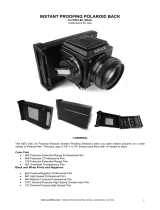
9
Maintenance
To clean the rollers
Lift the two metal loops as shown (28) and
remove the rollers. (The serial number is located
beneath the rollers.) To clean them, use a cloth
dampened with water (29). Never scrape the
rollers with anything metallic, nor with your
fingernail; do not attempt to disassemble the
rollers. Blow out any dust in the back of the
camera. Clean slots (30A) and (30B) if neces-
sary. Replace the rollers.
To test the camera batteries
Without film or electronic flash connected, set the
film selector to 80. Cover the electric eye with
your finger and aim the camera at a light (not the
sun). Press and hold down the shutter release.
You will hear a click. Uncover the electric eye.
You will hear a second click if the batteries are
good.
To change the camera batteries (at least
yearly)
With the camera’s front cover closed, open the
camera back. Pull down on the fingergrip (31A)
and remove the old batteries. Using two new
batteries (size AA, 1.5V alkaline), point the – end
of the left battery and the
+
end of the right
battery toward the top of the camera, as shown
on the battery holder (32A). Insert each battery
between the metal contacts. Close and latch the
fingergrip.
To change the ProFlash batteries
(ProPack System only)
If the flash takes more than 30 seconds to
charge, replace the batteries with four new
batteries (size AA, 1.5V alkaline) as described
under “Load the batteries into the ProFlash.”
Rechargeable 1.2V nickel-cadmium batteries
also can be used.
ProFlash battery life: To prevent draining the
batteries, always turn off the ProFlash when not
in use. (To help prevent battery drain, the flash
unit will automatically shut off after about three
minutes.) To maximize battery life, turn off the
electronic flash immediately after taking a flash
picture, before it has a chance to recharge.
To change the digital timer batteries
If the display or tones fade, or the timer stops
functioning, open the battery cover and replace
the batteries with two new batteries (GP-89A or
equivalent, 1.5V), positioned as shown (33).
Replace the cover. To restore the display, press
SET and START simultaneously.
Storage of the ProFlash
(ProPack System only)
If you are storing the unit for an extended period,
remove the batteries and store them separately.
This will prevent possible damage to the unit
from leaking batteries. Protect the flash unit from
moisture and from extreme heat and cold. Stor-
age in extreme temperatures can shorten battery
life. Keep the batteries and battery contacts
clean.
To rethread the neckstrap
If you remove the neckstrap, be sure to thread it
as shown in the illustration (34) when replacing
it on the camera. It is particularly important to
thread it as shown when the Polaroid ProFlash
is attached to the camera.
To clean the camera lens
Wipe it with a clean cloth. Never use silicone-
treated eyeglass tissue.
Never leave your equipment in a hot, humid
place.
Repairs
If you believe your equipment needs repair,
before you send it to us, call the Polaroid
Resource Center toll free and explain the prob-
lem. You may be able to use your equipment
again right away, without repair.
Your Polaroid dealer will return your equip-
ment for repair, should that ever be necessary.
Or you may bring it to a Polaroid Service Center,
which offers walk-in service. Many repairs can
be made while you wait.
Or, you may mail the equipment to Polaroid
for repairs. Pack it carefully. Address it to the
nearest Polaroid Service Center and send it by
insured parcel post. Include a note describing
the problem and, if you can, pictures that illus-
trate it.

















